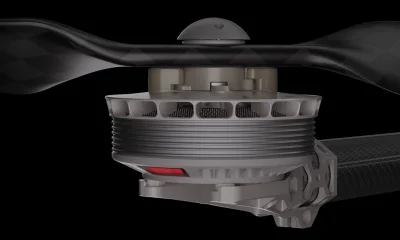Counter Drone
Counter-Drone Systems
Published
2 months agoon
Table Of Contents

As drones become more capable, accessible, and widely deployed, the need to defend sensitive airspace is growing rapidly. Whether for military security, public safety, or infrastructure protection, counter-drone systems are now critical tools in modern defense strategies. But with so many technologies emerging, which ones are actually proving effective on the ground?
In this article, we rank the top five counter-drone system types currently being used around the world—not by brand, but by the technology itself. These are the methods shaping how governments, security forces, and private operators detect, track, and disable unauthorized drones in real-time.
1. Radio Frequency (RF) Detection and Jamming

RF-based counter-drone systems are among the most widely used and mature technologies for drone detection and mitigation. These systems operate by scanning the radio frequency spectrum for the signals drones use to communicate with their controllers. Once a drone is detected, RF jamming systems can emit targeted signals to disrupt the communication link, forcing the drone into a failsafe mode—such as hovering, landing, or returning to its point of origin.
Some advanced RF systems also support direction finding, which helps triangulate the location of both the drone and its pilot—an especially valuable feature in law enforcement and battlefield applications.
How It Works
- Detection Phase: An RF sensor scans known drone control frequencies (such as 2.4 GHz, 5.8 GHz, and proprietary protocols like DJI’s Lightbridge or OcuSync). These sensors look for control signals, telemetry data, or video transmission links.
- Mitigation Phase: If a threat is confirmed, the system engages jammers that flood the communication frequency with noise. This breaks the link between drone and pilot, initiating the UAV’s automatic fail-safe response.
Why It’s Effective
- Silent Detection: Unlike radar, RF detection is passive—it doesn’t emit any signals, making it undetectable to the drone operator.
- Real-Time Response: RF jammers act immediately, with minimal delay between detection and disruption.
- Scalability: RF systems come in many forms—from handheld anti-drone rifles to vehicle-mounted arrays and fixed-installation platforms.
- Pilot Tracking: Directional RF systems can identify where a drone is being operated from, making it easier to apprehend unauthorized users.
Limitations
- Ineffective Against Autonomous Drones: RF jammers cannot stop drones flying autonomously without active control links.
- Encryption Challenges: Some modern drones use encrypted signals, making them harder to detect or identify through standard RF signatures.
- Collateral Interference: Jamming RF signals may disrupt legitimate communications nearby, such as Wi-Fi or GPS, depending on how the system is configured.
- Legal Restrictions: In many countries, jamming is regulated or prohibited outside of military or government use, limiting adoption by civilian security teams.
Where It’s Commonly Deployed
- Military Operations: Mobile jamming units are used to protect troops and convoys from FPV drones and UAV surveillance.
- Event Security: Stadiums and public events use fixed or mobile RF detection systems to identify potential threats without alerting the public.
- Critical Infrastructure: Prisons, government facilities, airports, and power plants rely on RF detection and jamming to prevent smuggling, espionage, or flight disruptions.
Why It Ranks #1
Despite its limitations, RF detection and jamming currently represent the most widely used and cost-effective foundation for counter-drone operations. When paired with other technologies like radar and optical tracking, RF systems form the backbone of most layered defense solutions today.
2. Radar-Based Detection Systems

Radar is a core detection technology in many counter-drone systems, particularly in environments where long-range visibility and early threat detection are critical. These systems emit radio waves and analyze their reflections off objects in the airspace, allowing operators to detect flying drones—even small ones—based on their movement, speed, size, and altitude.
Unlike RF detection, which relies on the presence of a control signal, radar can spot autonomous drones that operate without a live radio link. This makes radar an essential layer in any defense system where passive RF tools may fail.
How It Works
- Emission: The radar system transmits high-frequency radio waves into the surrounding environment.
- Reflection: When those waves bounce off an object—like a drone—the radar receiver collects the reflected signal.
- Analysis: Software then analyzes the size, speed, altitude, and flight path to determine whether the object is a bird, aircraft, or drone.
- Tracking: Once a drone is detected, radar systems track its position in real time and feed this data into larger command and control platforms for threat assessment or mitigation.
Why It’s Effective
- Works in All Weather and Light Conditions: Unlike cameras or thermal sensors, radar is unaffected by fog, smoke, darkness, or glare.
- Detects Autonomous UAVs: Since radar doesn’t depend on signal interception, it can identify drones flying pre-programmed missions without any active RF signature.
- Covers Large Areas: Radar can monitor vast airspace, often with a 360° field of view and ranges exceeding several kilometers.
- Real-Time Tracking: Radar offers continuous, live tracking that updates instantly as a drone moves.
Limitations
- Cost and Complexity: Radar systems are more expensive and harder to deploy than RF-only tools, especially for smaller organizations.
- False Positives: Small drones often resemble birds on radar. Differentiating between them requires advanced software or sensor fusion with optical systems.
- Cluttered Environments: Urban areas can cause signal reflection or absorption, making it harder to track drones near buildings or tight structures.
- No Mitigation Capability: Radar is purely a detection tool. It needs to be paired with jamming, spoofing, or kinetic systems to neutralize threats.
Where It’s Commonly Deployed
- Airports: Radar forms the backbone of drone threat detection for major international hubs.
- Military Bases and Borders: Used for long-range surveillance, particularly against reconnaissance or strike drones.
- Industrial Sites: Radar covers wide areas and integrates with automated security systems for early warning.
Why It Ranks #2
Radar’s ability to detect drones in all conditions—including autonomous UAVs—makes it an indispensable tool in any high-risk or large-area environment. When combined with other technologies, it offers unmatched reliability for early drone threat detection.
3. Electro-Optical and Infrared (EO/IR) Systems

Electro-optical (EO) and infrared (IR) systems use visual and thermal imaging to detect, classify, and track drones in real time. These systems are most often used in combination with RF or radar tools to provide visual confirmation of a potential threat and enhance situational awareness.
EO sensors rely on daylight or ambient lighting to generate high-resolution visual imagery. IR sensors, on the other hand, detect heat signatures—useful for spotting drones at night or in environments where visual detection is impaired. Together, they create a powerful dual-layer visual system that can verify and monitor aerial threats with clarity.
How It Works
- EO (Daylight): Uses optical zoom and image processing to identify drone shapes, flight patterns, and payloads.
- IR (Thermal): Detects the drone’s heat signature, including motor warmth or battery discharge, which helps in low-visibility conditions.
- Visual Tracking: Once a drone is detected via radar or RF, EO/IR cameras automatically pan, tilt, and zoom to lock on the UAV, tracking it until the threat is neutralized or leaves the area.
Why It’s Effective
- Visual Confirmation: Offers undeniable proof that an object is a drone, which helps security teams decide whether to act.
- Day and Night Coverage: Combines full-color daytime imagery with thermal visibility after dark.
- Supports Targeted Mitigation: Optical tracking allows for precision jamming or kinetic targeting (e.g., laser neutralization or drone interceptors).
- Integrates Easily: EO/IR sensors can be mounted on towers, vehicles, or paired with drone platforms for aerial overwatch.
Limitations
- Line-of-Sight Required: Cameras must have a clear view of the drone. Obstructions like buildings, foliage, or terrain can limit detection.
- Weather Dependent: Fog, rain, and haze can degrade EO image quality, although IR performance remains relatively stable.
- Identification Range: While radar can detect objects miles away, EO/IR systems typically have shorter effective ranges depending on the lens and resolution.
- High Operator Involvement: Often requires human operators to monitor feeds and make decisions unless paired with AI-assisted software.
Where It’s Commonly Deployed
- Urban Environments: EO/IR helps distinguish drones from birds or other moving objects when radar alone is insufficient.
- Critical Infrastructure: Used to maintain constant visual oversight of sensitive airspace.
- Military Operations: Deployed on watchtowers, vehicles, or integrated into command posts for battlefield awareness.
Why It Ranks #3
EO/IR systems provide the human eyes and confirmation that other sensors can’t offer. While they are limited by environment and line-of-sight, they remain a key element in precision counter-drone workflows—especially when it’s critical to visually confirm a threat before taking action.
4. Drone Interceptor Systems (Drone-on-Drone Defense)

Drone interceptor systems represent one of the most dynamic and active approaches to counter-drone operations. These systems deploy a secondary drone—often autonomous or semi-autonomous—to locate, pursue, and disable a rogue UAV mid-flight. Instead of relying on jamming or spoofing, interceptor drones take direct physical action, either by deploying nets, colliding with the intruding drone, or delivering a disabling payload.
This approach is particularly useful in urban environments, sensitive areas where jamming could disrupt other equipment, or situations where surgical precision is required to neutralize a drone without endangering nearby people or infrastructure.
How It Works
- Autonomous Targeting: Interceptor drones are equipped with onboard sensors, cameras, and real-time data feeds from ground-based radar or EO/IR systems.
- Launch and Lock: Upon detection of a threat, the interceptor launches and locks onto the rogue drone’s GPS coordinates or visual signature.
- Engagement: The interceptor uses a net, mechanical arm, or direct kinetic contact to capture, disable, or crash the target drone.
- Recovery or Neutralization: In some cases, the captured drone is brought back using a parachute system; in others, the drone is safely brought down away from crowds or assets.
Why It’s Effective
- Precise and Controlled: Great for environments where RF jamming is risky or restricted.
- No RF Dependency: Works regardless of whether the target drone is transmitting signals or operating autonomously.
- Minimal Collateral Damage: Systems can capture drones safely or direct them away from vulnerable zones.
- Visually Deniable: Because interceptors are small and fast, their engagement often appears less disruptive than ground-based action.
Limitations
- Short Range: Interceptors are usually limited to a few hundred meters from their launch point.
- Limited Payload and Battery Life: These drones are lightweight and must return after a single intercept or short mission.
- Expensive to Deploy Per Incident: Using a drone to capture another drone isn’t always cost-effective, especially in high-volume environments.
- Requires Detection Infrastructure: Most systems rely on radar or visual detection to initiate engagement, meaning they’re not standalone solutions.
Where It’s Commonly Deployed
- Airports and Stadiums: Where jamming is not viable due to interference risks.
- VIP Protection: Used for high-profile events to neutralize threats precisely.
- Military Installations: For short-range defense against FPV drones and recon units.
- Urban Environments: Where net capture and parachute recovery reduce the risk to civilians.
Why It Ranks #4
Drone-on-drone interception is one of the most advanced and precise counter-UAV tactics available today. While not suitable for all situations, it excels in high-value environments where collateral damage, legal risk, or infrastructure sensitivity makes traditional mitigation options unworkable.
5. GNSS Spoofing and Signal Manipulation

GNSS spoofing (Global Navigation Satellite System spoofing) is a sophisticated counter-drone method that manipulates the drone’s sense of its own location. Unlike jamming, which blocks signals, spoofing deceives the drone into receiving false positioning data. By feeding fake GPS coordinates to the drone, operators can trick it into landing, veering off course, or returning to an incorrect “home” point.
Spoofing is particularly effective against semi-autonomous drones that rely heavily on GPS navigation. It’s often used in sensitive areas where jamming could disrupt nearby systems like communication towers, commercial aircraft, or emergency response networks.
How It Works
- Interception Setup: A GNSS spoofing device broadcasts false satellite signals designed to be stronger than real ones in the drone’s vicinity.
- Takeover Process: The drone begins accepting the spoofed data as accurate, gradually adjusting its position or altitude based on these new coordinates.
- Controlled Misdirection or Landing: Spoofing systems can force the drone to land, drift off course, or circle in a safe area for capture or investigation.
Why It’s Effective
- Covert and Non-Disruptive: Unlike jamming, spoofing doesn’t create broad-spectrum interference and is often undetectable to the drone’s pilot.
- No Contact Required: Spoofing manipulates navigation without needing visual or physical engagement.
- Ideal for GPS-Reliant Drones: Many commercial drones depend heavily on GNSS systems for stability, navigation, and return-to-home functions.
- Safe Mitigation: Allows operators to redirect drones away from sensitive locations instead of disabling them abruptly.
Limitations
- Complex and Sensitive: Requires precise timing, geographic knowledge, and calibration to be successful.
- Ineffective Against Non-GPS Drones: FPV drones or UAVs using vision-based navigation won’t respond to spoofed signals.
- Legal Restrictions: GNSS manipulation is regulated or outright banned in many regions due to potential misuse and interference with legitimate GPS services.
- Slow Reaction Time: Spoofing is less effective during fast-moving, close-range attacks, such as FPV drones or swarm tactics.
Where It’s Commonly Deployed
- Military Installations and Forward Operating Bases: To quietly redirect or neutralize reconnaissance drones.
- Airports and Communication Centers: Where jamming is risky but GPS manipulation can redirect drones without disruption.
- VIP Convoys and Urban Facilities: Environments requiring low-visibility and non-destructive threat mitigation.
Why It Ranks #5
GNSS spoofing offers a highly targeted, non-aggressive option for neutralizing drones—but it comes with complexity, regulatory risk, and limitations in dynamic combat scenarios. While not as widely adopted as RF jamming or radar, it remains a critical tool in the right environments—especially where stealth and precision are paramount.
Industry Leaders in Counter-Drone Systems
1. RF Detection & Jamming – DroneShield

Headquarters: Australia / USA
Leading Technology: RF-based detection and disruption
Flagship Products: DroneSentry, DroneGun Tactical, DroneNode
DroneShield is a global leader in RF-based counter-drone defense. Its systems detect UAVs by scanning known control frequencies and disrupt threats using high-powered jamming. The DroneGun Tactical, a shoulder-fired jammer, and the DroneSentry integrated platform are actively deployed by military and law enforcement units worldwide. With scalable options for both fixed and mobile use, DroneShield has set the standard for RF-based drone defense.
2. Radar-Based Detection – Robin Radar Systems

Headquarters: Netherlands
Leading Technology: Compact, high-resolution radar
Flagship Products: ELVIRA, IRIS®
Robin Radar Systems is a pioneer in radar technology optimized for detecting small aerial targets like drones. Their ELVIRA radar system is specifically designed for drone detection and classification, providing 360° coverage and the ability to distinguish between UAVs and birds. Robin’s radar platforms are deployed at major airports, military bases, and critical infrastructure across Europe and beyond.
3. Electro-Optical / Infrared (EO/IR) – FLIR Systems (Teledyne FLIR)

Headquarters: USA
Leading Technology: Visual and thermal tracking
Flagship Products: Ranger HDC, Cameleon Tactical Integration
Teledyne FLIR leads the EO/IR sector with advanced visual and thermal imaging systems. Their high-definition day/night sensors support long-range tracking and facial-level detail. The Ranger HDC multi-sensor camera suite is widely used for drone detection and target verification, especially when paired with radar and RF systems. FLIR’s Cameleon software also enables integration with surveillance networks and automated alert systems.
4. Drone Interceptor Systems – Fortem Technologies

Headquarters: USA
Leading Technology: Autonomous drone interception
Flagship Product: DroneHunter®
Fortem Technologies developed one of the first fully autonomous drone interception systems: the DroneHunter®. Using radar guidance and onboard AI, the DroneHunter chases down and captures unauthorized drones mid-flight using a net. It’s deployed by military and homeland security forces to protect airspace where traditional mitigation (like jamming) may not be viable or safe.
5. GNSS Spoofing – SKYLOCK (Avnon Group)
Headquarters: Israel
Leading Technology: Satellite signal manipulation
Flagship Products: GNSS Spoofer, Portable Anti-Drone Suite
SKYLOCK specializes in spoofing and signal redirection tools designed to safely neutralize drones by feeding them false GPS data. Their portable GNSS Spoofer allows operators to force drones to land or redirect them to a safer zone without triggering failsafes or causing interference. SKYLOCK’s tools are used by defense agencies in environments where electronic jamming isn’t practical or allowed.
How Counter Drone Systems Are Built to Handle Modern UAV Threats
Counter drone systems are no longer optional tools—they are essential components of modern security infrastructure. These systems are designed to detect, track, identify, and neutralize drones across a wide variety of threat profiles. Whether dealing with consumer drones used for surveillance or militarized UAVs deployed for sabotage or attacks, counter drone systems offer a layered defense strategy.
Modern systems typically combine multiple technologies, such as RF detection, radar, optical tracking, and mitigation tools like jammers or drone interceptors. This multi-sensor approach ensures accurate identification and minimizes false positives—an increasingly important factor as drones become smaller, faster, and more autonomous. These systems are being actively deployed at airports, government buildings, military bases, data centers, and even major public events where airspace control is critical.
Why Counter Drone Systems Must Adapt to an Evolving Threat Landscape
The growing sophistication of drone technology has pushed counter drone systems to evolve rapidly. Where early systems focused on simple jamming or visual detection, modern solutions now require AI-powered classification, real-time threat assessment, and the ability to deal with swarming drones or RF-silent UAVs.
Counter drone systems today must address new challenges, such as drones flying pre-programmed GPS missions without active control links, or FPV drones used in close-range attacks that respond too quickly for manual defenses. As a result, leading systems are becoming more automated, scalable, and modular—capable of defending fixed locations, mobile assets, and rapidly shifting perimeters.
The continued integration of artificial intelligence, fiber optic surveillance platforms, and networked sensor grids ensures that counter drone systems remain adaptable and relevant in a fast-changing threat environment.
Frequently Asked Questions About Counter Drone Systems
What are counter drone systems and how do they work?
Counter drone systems are integrated technologies designed to detect, identify, track, and neutralize unauthorized or hostile drones. They use a combination of radar, radio frequency sensors, optical cameras, infrared imaging, jammers, and even drone interceptors to protect airspace across military, commercial, and civilian settings.
Where are counter drone systems typically deployed?
You’ll find counter drone systems installed at airports, military bases, government buildings, critical infrastructure, stadiums, prisons, and border zones. They’re also increasingly used at public events and by private security teams to safeguard restricted airspace and respond to emerging threats.
Can counter drone systems stop autonomous or GPS-guided drones?
Yes, advanced counter drone systems can address autonomous drones through technologies like radar tracking, optical identification, and GPS spoofing. These tools don’t rely on RF signal detection, allowing them to neutralize drones without control links or live telemetry.
Are counter drone systems legal to use?
Laws vary by country. In most regions, only authorized government or military agencies can deploy jamming or kinetic countermeasures. However, detection-only systems (such as RF sensors or radar) are typically legal for commercial and civilian use. It’s essential to follow local regulations when selecting and deploying counter drone solutions.
How accurate are modern counter drone systems?
When layered correctly, modern counter drone systems can achieve high accuracy with low false-positive rates. Systems that combine RF detection, radar, and EO/IR verification offer the most reliable results, especially when paired with AI for object classification.
What is the difference between a drone jammer and a full counter drone system?
A drone jammer is a single-purpose device designed to disrupt communication between a drone and its operator. A full counter drone system includes detection, tracking, classification, and mitigation capabilities—offering a complete airspace security solution.
Can counter drone systems handle drone swarms?
Some advanced systems, especially those used by militaries, are designed to respond to multiple drone threats at once. These counter drone systems use AI-powered tracking, radar fusion, and automated mitigation tools to defend against coordinated swarm attacks.











